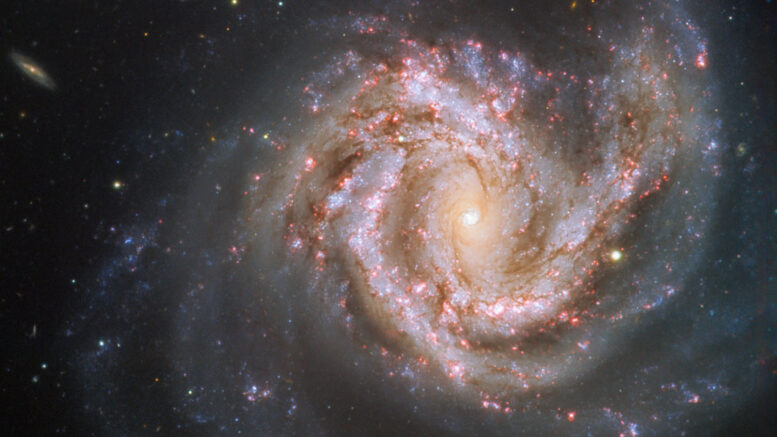| Description | |
| Visible From Pacific Northwest | December to May |
| Best Time To Observe | March, April, and May |
| Minimum Size Of Viewing Device | Small/Medium Sized Telescope |
| Object Type | Barred Spiral Galaxy |
| Designations | Messier 61, M61, NGC 4303, PGC 040001, UGC 07420, MCG +01-32-022, USGC U490 NED310, MRC 1219+047, GC 2878, BWE 1219+0445, 2E 1219.3+0445, IRAS F12193+0445, NVSS J122154+042825, RGB J1221.8+0429, RX J1221.9+0429, VCC 508, Z 42-45 |
| Right Ascension | 12h 21m 54.9s |
| Declination | +04°28’25” |
| Constellation | Virgo |
| Number Of Stars | More Than 300 Billion |
| Apparent magnitude | +10.18 |
| Apparent dimensions | 6′.5 x 5′.8 |
| Object Radius | 50,000 light years |
| Distance From Earth | 52.5 million light years |
History
Messier 61 was discovered by the Italian astronomer Barnaba Oriani on May 5, 1779. Oriani described the object as “very pale and looking exactly like the comet [1779 Bode, C/1779 A1].”
Charles Messier first spotted the object on the same night as Oriani, but mistook it for the comet mentioned by the Italian astronomer. He realised a few days later that the object was not moving and added it to his catalogue.
William Herschel catalogued the object as H I.139 on April 17, 1786, describing it as “extremely bright. Very bright nucleus. Resolvable. 6 or 7′ diameter.”
John Herschel catalogued M61 as h 1202 in April 1828 and later added the object to the General Catalogue as GC 2878, describing it as “very bright; very large; very suddenly much brighter toward the middle which is starlike; binuclear.”
Locating M61 In The Sky
Messier 61 lies just above the line between Auva (Minelauva), Delta Virginis, to Zavijava, Beta Virginis. It can be seen 8 degrees to the northwest of Porrima, Gamma Virginis, and only 1.25 degrees to the north-northeast of 16 Virginis.
The galaxy can also be found along the line from Spica, the brightest star in Virgo, to Denebola, the third brightest star in the neighbouring constellation Leo.
\
Viewing M61
The best time of year to observe M61 is during the spring. Small telescopes show M61 as a faint oval-shaped patch with a bright core, while medium-sized and large telescopes reveal a very clear nucleus and a hint of the galaxy’s spiral arms. The spiral arms and details of the galaxy’s structure become much clearer in 10-inch and 12-inch telescopes.
Photographing M61
There are a plethora of options for imaging M61. It is recommended to utilize autoguiding and a larger telescope. The more time spent gathering images on a larger scope with different filters and gathering darks, the better the image will be.
https://www.cloudynights.com/topic/708981-small-but-brave-messier-61/
https://www.cloudynights.com/topic/708276-supernova-in-m61-using-the-gso-16rc/
https://www.cloudynights.com/topic/695705-messier-61-ngc-4292-and-ngc-4301/
Sources And Further Reading
Descriptions of all of Messier Objects can be found here.
https://www.nasa.gov/feature/goddard/2017/messier-61
https://freestarcharts.com/messier-61

Be the first to comment on "Messier 61"